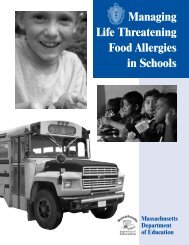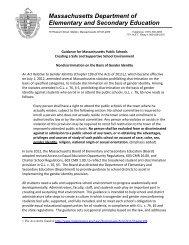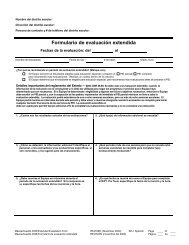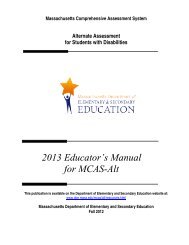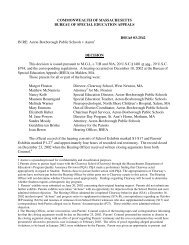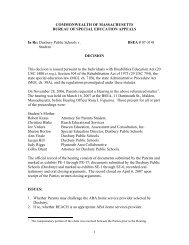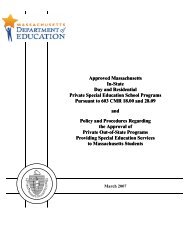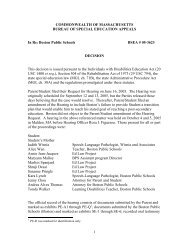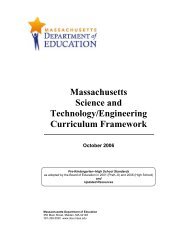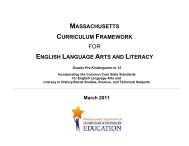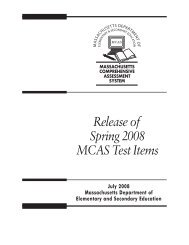IV. English Language Arts, Reading Comprehension, Grade 5
IV. English Language Arts, Reading Comprehension, Grade 5
IV. English Language Arts, Reading Comprehension, Grade 5
You also want an ePaper? Increase the reach of your titles
YUMPU automatically turns print PDFs into web optimized ePapers that Google loves.
<strong>IV</strong>. <strong>English</strong> <strong>Language</strong> <strong>Arts</strong>,<br />
<strong>Reading</strong> <strong>Comprehension</strong>, <strong>Grade</strong> 5
<strong>Grade</strong> 5 <strong>English</strong> <strong>Language</strong> <strong>Arts</strong><br />
<strong>Reading</strong> <strong>Comprehension</strong> Test<br />
The spring 2012 grade 5 <strong>English</strong> <strong>Language</strong> <strong>Arts</strong> <strong>Reading</strong> <strong>Comprehension</strong> test was based on learning<br />
standards in the two content strands of the Massachusetts <strong>English</strong> <strong>Language</strong> <strong>Arts</strong> Curriculum<br />
Framework (2001) listed below. Specific learning standards for grade 5 are found in the Supplement to<br />
the Massachusetts <strong>English</strong> <strong>Language</strong> <strong>Arts</strong> Curriculum Framework (2004). Page numbers for the learning<br />
standards appear in parentheses.<br />
■ <strong>Language</strong> (Framework, pages 19–26; Supplement, page 10)<br />
■ <strong>Reading</strong> and Literature (Framework, pages 35–64; Supplement, pages 11–13)<br />
The <strong>English</strong> <strong>Language</strong> <strong>Arts</strong> Curriculum Framework and Supplement are available on the Department<br />
website at www.doe.mass.edu/frameworks/current.html.<br />
ELA <strong>Reading</strong> <strong>Comprehension</strong> test results are reported under two MCAS reporting categories, <strong>Language</strong><br />
and <strong>Reading</strong> and Literature, which are identical to the two framework content strands listed above.<br />
Test Sessions and Content Overview<br />
The grade 5 ELA <strong>Reading</strong> <strong>Comprehension</strong> test included two separate test sessions. Each session included<br />
reading passages, followed by multiple-choice and open-response questions. Selected common reading<br />
passages and approximately half of the common test items are shown on the following pages as they<br />
appeared in test booklets.<br />
Reference Materials<br />
The use of bilingual word-to-word dictionaries was allowed for current and former <strong>English</strong> language<br />
learner students only, during both ELA <strong>Reading</strong> <strong>Comprehension</strong> sessions. No other reference materials<br />
were allowed during any ELA <strong>Reading</strong> <strong>Comprehension</strong> test session.<br />
Cross-Reference Information<br />
The tables at the conclusion of this chapter indicate each released and unreleased common item’s reporting<br />
category and the framework general standard it assesses. The correct answers for released multiple-choice<br />
questions are also displayed in the released item table.<br />
40
DIRECTIONS<br />
This session contains two reading selections with sixteen multiple-choice questions and two openresponse<br />
questions. Mark your answers to these questions in the spaces provided in your Student<br />
Answer Booklet.<br />
Read the selection to find out why some plants smell bad. Then answer the questions that follow.<br />
1<br />
2<br />
3<br />
4<br />
5<br />
Foul Flora<br />
by Marilyn Singer<br />
The Rancid Rafflesia<br />
What weighs as much as a miniature poodle and<br />
smells as bad as rotten dog food? Would you believe<br />
it’s a flower? The rafflesia is the world’s largest flower.<br />
When it’s in full bloom, it can weigh up to fifteen<br />
pounds and be a yard wide. Found on rain forest floors<br />
in Indonesia, Borneo, and Sumatra, it is a parasite that<br />
lives off the roots of a vine related to the grapevine.<br />
Having no roots, stems, leaves, or chlorophyll, the<br />
rafflesia gets its food from that plant.<br />
The rafflesia takes nine months to reach full size.<br />
Then it bursts out like a big, orange cabbage and<br />
expands into a blossom as much as three feet wide and<br />
up to fifteen pounds in weight. Flowering for just four<br />
raff lesia blossom<br />
to six days, it fills the air with a stench like carrion,*<br />
which has earned it the name “stinking corpse lily.”<br />
Why would any flower smell like that? The answer has to do with pollination.<br />
Two, Four, Six, Eight—<br />
Now’s the Time to Pollinate!<br />
In order to reproduce, most flowers need to be pollinated. For flowers to make fruit and seeds,<br />
pollen from the male parts needs to reach the female parts. Some plants can pollinate themselves.<br />
Others must be pollinated by wind, water, or animals.<br />
If a flower smells yummy during the day, chances are that it is pollinated by butterflies, bees,<br />
wasps, certain beetles, or other insects that are attracted to sweet odors. Pollen clings to them<br />
and is deposited on other blossoms. Pale or white flowers that are fragrant at night usually attract<br />
moths. Dull-colored, odorless plants are often wind-pollinated. Some bright, odorless blooms<br />
may be pollinated by birds, such as hummingbirds, which have a poor sense of smell. The birds<br />
* carrion — decaying flesh<br />
<strong>English</strong> <strong>Language</strong> <strong>Arts</strong><br />
<strong>Reading</strong> CompRehension<br />
41
<strong>Reading</strong> <strong>Comprehension</strong><br />
6<br />
7<br />
8<br />
9<br />
10<br />
go to drink nectar, and the pollen sticks to their<br />
feathers or beaks. Colorful but unscented flowers<br />
also appeal to bees, wasps, and butterflies, which<br />
look for blossoms of particular colors and shapes<br />
and not just scent. And if a flower smells—and<br />
sometimes even looks—bad, it lures flies, carrion<br />
beetles, or other critters that love the putrid odor of<br />
rotten meat or fish.<br />
Going Batty!<br />
Flies and beetles aren’t the only creatures<br />
attracted to smelly flowers. Many plants are<br />
pollinated by bats. What odors do bats prefer?<br />
Some like the smell of rotting fruit. And some like<br />
the musty aroma of fellow bats.<br />
In Africa, the baobab tree (Adansonia digitata)<br />
produces gorgeous blossoms that reek rather like<br />
these flying mammals. Because bats are nocturnal,<br />
the flowers open at night and are pale in color so<br />
the bats can see (and smell) them more easily. While they are eating the flowers’ nectar, the pollen<br />
sticks to the bats’ fur or mouths. As they fly from bloom to bloom, they transfer it.<br />
The baobab is a magnificent and important plant. Animals live in its branches. People use<br />
all of it—the bark for cloth and rope, the leaves for medicine, the fruit for food—and sometimes<br />
even take shelter inside its huge trunk.<br />
Another important relative of the baobab is the<br />
silk cotton tree (Ceiba pentandra). This tree’s fruits<br />
produce kapok—a fluffy material once widely used in<br />
lifejackets, sleeping bags, quilts, mattresses, and pillows<br />
because it is buoyant and warm. In many places the<br />
wood is still used to make canoes. Like the baobab, the<br />
kapok has malodorous flowers that attract bats. In some<br />
places, bats appear to be the plant’s only pollinator and<br />
seed disperser. Eliminate the bats, and you eliminate<br />
the tree—one of many good reasons to protect these<br />
mammals.<br />
Baobab and kapok blossoms, like carrion flowers,<br />
certainly smell great to their animal pollinators, but<br />
there’s a good chance Mom won’t like them. So when it<br />
comes to Mother’s Day, it’s best to stick with roses.<br />
“Foul Flora” by Marilyn Singer, from What Stinks? Copyright © 2006 by Marilyn Singer. Reprinted by permission of Darby Creek, a division<br />
of Lerner Publishing Group, Inc. Photograph 1 copyright © iStockphoto/wrangel. Photograph 2 copyright © iStockphoto/jeu. Photograph 3<br />
copyright © iStockphoto/Angela Bell.<br />
42<br />
field of baobab trees<br />
kapok blossom
<strong>Reading</strong> <strong>Comprehension</strong><br />
ID:287624 B Common<br />
● 1 Based on the selection, where does the<br />
rafflesia get its food?<br />
A. from carrion beetles<br />
B. from another plant<br />
C. from bats<br />
D. from soil<br />
ID:287625 A Common<br />
● 2 Based on paragraph 5, how does a plant<br />
attract insects at night?<br />
A. by its appearance and odor<br />
B. by its appearance and size<br />
C. by its location and odor<br />
D. by its location and size<br />
43<br />
ID:276325 B Common<br />
● 3 What is the best conclusion that can<br />
be drawn from the information in<br />
paragraph 5?<br />
A. Plants do not rely on pollination<br />
to reproduce.<br />
B. Plants have many ways to appeal<br />
to pollinators.<br />
C. Plants must be pollinated by more<br />
than one animal.<br />
D. Plants do not make pollen at certain<br />
times of the year.
<strong>Reading</strong> <strong>Comprehension</strong><br />
ID:276334 C Common<br />
● 4 According to the selection, what would<br />
most likely happen if bats were to<br />
disappear from Earth?<br />
A. Flowers would become<br />
more fragrant.<br />
B. Baobab trees would become<br />
more common.<br />
C. Silk cotton trees would no longer<br />
reproduce.<br />
D. Colorless flowers would no longer<br />
be necessary.<br />
ID:276331 A Common<br />
● 5 According to paragraph 8, why is the<br />
baobab tree important?<br />
A. It serves many different<br />
purposes.<br />
B. It is one of the oldest trees<br />
in the world.<br />
C. It is one of the largest trees<br />
in the world.<br />
D. It stores water in periods of<br />
dry weather.<br />
44<br />
ID:276343 A Common<br />
● 6 Read the sentence from paragraph 9 in<br />
the box below.<br />
Like the baobab, the kapok has<br />
malodorous flowers that attract bats.<br />
The prefix mal- means “bad.” What does<br />
the word malodorous mean?<br />
A. stinky<br />
B. strange<br />
C. prickly<br />
D. poisonous
<strong>Reading</strong> <strong>Comprehension</strong><br />
Question 7 is an open-response question.<br />
• Read the question carefully.<br />
• Explain your answer.<br />
• Add supporting details.<br />
• Double-check your work.<br />
Write your answer to question 7 in the space provided in your Student Answer Booklet.<br />
ID:276348 Common<br />
● 7 Explain how the author makes the selection both entertaining and informative. Support your<br />
answer with important details from the selection.<br />
45
<strong>Reading</strong> <strong>Comprehension</strong><br />
In the imaginary land of Narnia, two animals—an ape named Shift and a donkey named Puzzle—are<br />
friends. Read the selection about one of their adventures and answer the questions that follow.<br />
1<br />
2<br />
3<br />
4<br />
* panniers — baskets<br />
BY CALDRON POOL<br />
by C. S. Lewis<br />
In the last days of Narnia, far up to the west beyond Lantern Waste and close beside<br />
the great waterfall, there lived an Ape. He was so old that no one could remember<br />
when he had first come to live in those parts, and he was the cleverest, ugliest, most<br />
wrinkled Ape you can imagine. He had a little house, built of wood and thatched<br />
with leaves, up in the fork of a great tree, and his name was Shift. There were very<br />
few Talking Beasts or Men or Dwarfs, or people of any sort, in that part of the<br />
wood, but Shift had one friend and neighbor who was a donkey called Puzzle. At<br />
least they both said they were friends, but from the way things went on you might<br />
have thought Puzzle was more like Shift’s servant than his friend. He did all the<br />
work. When they went together to the river, Shift filled the big skin bottles with<br />
water but it was Puzzle who carried them back. When they wanted anything from the<br />
towns further down the river it was Puzzle who went down with empty panniers* on<br />
his back and came back with the panniers full and heavy. And all the nicest things<br />
that Puzzle brought back were eaten by Shift; for as Shift said, “You see, Puzzle,<br />
I can’t eat grass and thistles like you, so it’s only fair I should make it up in other<br />
ways.” And Puzzle always said, “Of course, Shift, of course. I see that.” Puzzle never<br />
complained, because he knew that Shift was far cleverer than himself and he thought<br />
it was very kind of Shift to be friends with him at all. And if ever Puzzle did try<br />
to argue about anything, Shift would always say, “Now, Puzzle, I understand what<br />
needs to be done better than you. You know you’re not clever, Puzzle.” And Puzzle<br />
always said, “No, Shift. It’s quite true. I’m not clever.” Then he would sigh and do<br />
whatever Shift had said.<br />
One morning early in the year the pair of them were out walking along the shore<br />
of Caldron Pool. Caldron Pool is the big pool right under the cliffs at the western<br />
end of Narnia. The great waterfall pours down into it with a noise like everlasting<br />
thunder, and the River of Narnia flows out on the other side. The waterfall keeps<br />
the Pool always dancing and bubbling and churning round and round as if it were<br />
on the boil, and that of course is how it got its name of Caldron Pool. It is liveliest<br />
in the early spring when the waterfall is swollen with all the snow that has melted<br />
off the mountains from up beyond Narnia in the Western Wild from which the river<br />
comes. And as they looked at Caldron Pool Shift suddenly pointed with his dark,<br />
skinny finger and said,<br />
“Look! What’s that?”<br />
“What’s what?” said Puzzle.<br />
46
<strong>Reading</strong> <strong>Comprehension</strong><br />
5<br />
6<br />
7<br />
8<br />
9<br />
10<br />
11<br />
12<br />
13<br />
14<br />
15<br />
16<br />
“That yellow thing that’s just come down the waterfall. Look! There it is again,<br />
it’s floating. We must find out what it is.”<br />
“Must we?” said Puzzle.<br />
“Of course we must,” said Shift. “It may be something useful. Just hop into the<br />
Pool like a good fellow and fish it out. Then we can have a proper look at it.”<br />
“Hop into the Pool?” said Puzzle, twitching his long ears.<br />
“Well how are we to get it if you don’t?” said the Ape.<br />
“But—but,” said Puzzle, “wouldn’t it be better if you went in? Because, you see,<br />
it’s you who wants to know what it is, and I don’t much. And you’ve got hands, you<br />
see. You’re as good as a Man or a Dwarf when it comes to catching hold of things.<br />
I’ve only got hoofs.”<br />
“Really, Puzzle,” said Shift, “I didn’t think you’d ever say a thing like that. I<br />
didn’t think it of you, really.”<br />
“Why, what have I said wrong?” said the Ass, speaking in rather a humble voice,<br />
for he saw that Shift was very deeply offended. “All I meant was—”<br />
“Wanting me to go into the water,” said the Ape. “As if you didn’t know perfectly<br />
well what weak chests Apes always have and how easily they catch cold! Very well.<br />
I will go in. I’m feeling cold enough already in this cruel wind. But I’ll go in. I<br />
shall probably die. Then you’ll be sorry.” And Shift’s voice sounded as if he was<br />
just going to burst into tears.<br />
“Please don’t, please don’t, please don’t,” said Puzzle, half braying, and half<br />
talking. “I never meant anything of the sort, Shift, really I didn’t. You know how<br />
stupid I am and how I can’t think of more than one thing at a time. I’d forgotten<br />
about your weak chest. Of course I’ll go in. You mustn’t think of doing it yourself.<br />
Promise me you won’t, Shift.”<br />
So Shift promised, and Puzzle went cloppety-clop on his four hoofs round the<br />
rocky edge of the Pool to find a place where he could get in. Quite apart from the<br />
cold it was no joke getting into that quivering and foaming water, and Puzzle had<br />
to stand and shiver for a whole minute before he made up his mind to do it. But<br />
then Shift called out from behind him and said: “Perhaps I’d better do it after all,<br />
Puzzle.” And when Puzzle heard that he said, “No, no. You promised. I’m in now,”<br />
and in he went.<br />
A great mass of foam got him in the face and filled his mouth with water and<br />
blinded him. Then he went under altogether for a few seconds, and when he came<br />
up again he was in quite another part of the Pool. Then the swirl caught him and<br />
carried him round and round and faster and faster till it took him right under the<br />
waterfall itself, and the force of the water plunged him down, deep down, so that<br />
he thought he would never be able to hold his breath till he came up again. And<br />
when he had come up and when at last he got somewhere near the thing he was<br />
trying to catch, it sailed away from him till it too got under the fall and was forced<br />
down to the bottom. When it came up again it was further from him than ever. But<br />
at last, when he was almost tired to death, and bruised all over and numb with cold,<br />
he succeeded in gripping the thing with his teeth. And out he came carrying it in<br />
47
<strong>Reading</strong> <strong>Comprehension</strong><br />
17<br />
18<br />
19<br />
20<br />
21<br />
22<br />
23<br />
front of him and getting his front hoofs tangled up in it, for it was as big as a large<br />
hearthrug, and it was very heavy and cold and slimy.<br />
He flung it down in front of Shift and stood dripping and shivering and trying<br />
to get his breath back. But the Ape never looked at him or asked him how he felt.<br />
The Ape was too busy going round and round the Thing and spreading it out and<br />
patting it and smelling it. Then a wicked gleam came into his eye and he said:<br />
“It is a lion’s skin.”<br />
“Ee—auh—auh—oh, is it?” gasped Puzzle.<br />
“Now I wonder . . . I wonder . . . I wonder,” said Shift to himself, for he was<br />
thinking very hard.<br />
“I wonder who killed the poor lion,” said Puzzle presently. “It ought to be buried.<br />
We must have a funeral.”<br />
“Oh, it wasn’t a Talking Lion,” said Shift. “You needn’t bother about that. There<br />
are no Talking Beasts up beyond the Falls, up in the Western Wild. This skin must<br />
have belonged to a dumb, wild lion.”<br />
This, by the way, was true. A Hunter, a Man, had killed and skinned this lion<br />
somewhere up in the Western Wild several months before. But that doesn’t come<br />
into this story.<br />
“By Caldron Pool” by C.S. Lewis, from The Last Battle. Copyright © 1956 by C.S. Lewis Pte. Ltd. Reprinted by permission of The C.S. Lewis<br />
Company Ltd.<br />
48
<strong>Reading</strong> <strong>Comprehension</strong><br />
ID:287626 B Common<br />
● 8 In the selection, how does Shift mostly<br />
control Puzzle’s behavior?<br />
A. by telling Puzzle that he will be<br />
rewarded for obeying<br />
B. by reminding Puzzle that he is<br />
unintelligent<br />
C. by urging Puzzle to be more daring<br />
D. by warning Puzzle about danger<br />
ID:276049 D Common<br />
● 9 Based on paragraph 2, which of the<br />
following best explains how the Pool<br />
got its name?<br />
A. It is filled with unknown<br />
objects.<br />
B. It is deeper than other bodies<br />
of water.<br />
C. It is black and dirty like a kettle<br />
used for cooking.<br />
D. It is swirling and foaming like soup<br />
being stirred in a pot.<br />
49<br />
ID:276051 C Common<br />
● 10 According to the selection, why does<br />
Puzzle think it would be best for Shift<br />
to go into the water?<br />
A. Shift loves to go swimming.<br />
B. Puzzle feels he is becoming ill.<br />
C. Shift grabs things more easily<br />
than Puzzle.<br />
D. Puzzle knows Shift enjoys<br />
finding treasure.<br />
ID:287627 A Common<br />
● 11 Which of the following best describes<br />
what happens in paragraph 14?<br />
A. Puzzle gives in to Shift’s<br />
demands.<br />
B. Shift expresses concern for<br />
Puzzle’s health.<br />
C. Shift offers to go into the Pool<br />
instead of Puzzle.<br />
D. Puzzle explains why Shift should<br />
go into the Pool.
<strong>Reading</strong> <strong>Comprehension</strong><br />
ID:276119 D Common<br />
● 12 Which of the following statements best<br />
describes what happens in paragraph 15?<br />
A. Shift asks Puzzle to forget about the<br />
object in the Pool.<br />
B. Shift decides that he should let Puzzle<br />
go into the Pool.<br />
C. Shift apologizes to Puzzle for forcing<br />
him to go into the Pool.<br />
D. Shift watches while Puzzle gathers his<br />
courage to enter the Pool.<br />
ID:276120 B Common<br />
● 13 Read the description from paragraph 16<br />
in the box below.<br />
Then the swirl caught him and carried<br />
him round and round and faster and<br />
faster . . . and the force of the water<br />
plunged him down, deep down, . . .<br />
What is the main effect of repeating the<br />
words “round,” “faster,” and “down” in<br />
the description?<br />
A. It suggests that Puzzle is<br />
dreaming.<br />
B. It suggests the power of the<br />
current.<br />
C. It shows how strongly Puzzle<br />
swims.<br />
D. It shows the weight of the yellow<br />
object.<br />
50<br />
ID:276124 D Common<br />
● 14 Who is telling the story?<br />
A. Shift<br />
B. a lion<br />
C. Puzzle<br />
D. a narrator<br />
ID:276125 B Common<br />
● 15 Which of the following is the best clue<br />
that the selection is a fantasy?<br />
A. The characters find a hidden object.<br />
B. The characters are animals that talk.<br />
C. The characters experience a conflict.<br />
D. The characters perform a brave deed.
<strong>Reading</strong> <strong>Comprehension</strong><br />
ID:276128 D Common<br />
● 16 Read the sentence from paragraph 7 in<br />
the box below.<br />
“Just hop into the Pool like a good<br />
fellow and fish it out.”<br />
Which of the following words in the<br />
sentence is used as a verb?<br />
A. Just<br />
B. Pool<br />
C. good<br />
D. fish<br />
Question 18 is an open-response question.<br />
• Read the question carefully.<br />
• Explain your answer.<br />
• Add supporting details.<br />
• Double-check your work.<br />
51<br />
ID:276127 A Common<br />
● 17 In paragraph 12, what does the word<br />
offended mean?<br />
A. hurt<br />
B. modest<br />
C. pleased<br />
D. surprised<br />
Write your answer to question 18 in the space provided in your Student Answer Booklet.<br />
ID:276129 Common<br />
● 18 Based on the selection, describe the differences between Shift’s and Puzzle’s personalities.<br />
Support your answer with important details from the selection.
<strong>Grade</strong> 5 <strong>English</strong> <strong>Language</strong> <strong>Arts</strong><br />
<strong>Reading</strong> <strong>Comprehension</strong><br />
Spring 2012 Released Items:<br />
Reporting Categories, Standards, and Correct Answers*<br />
Item No. Page No. Reporting Category Standard<br />
52<br />
Correct Answer<br />
(MC)*<br />
1 43 <strong>Reading</strong> and Literature 8 B<br />
2 43 <strong>Reading</strong> and Literature 13 A<br />
3 43 <strong>Reading</strong> and Literature 13 B<br />
4 44 <strong>Reading</strong> and Literature 13 C<br />
5 44 <strong>Reading</strong> and Literature 8 A<br />
6 44 <strong>Language</strong> 4 A<br />
7 45 <strong>Reading</strong> and Literature 13<br />
8 49 <strong>Reading</strong> and Literature 12 B<br />
9 49 <strong>Reading</strong> and Literature 15 D<br />
10 49 <strong>Reading</strong> and Literature 8 C<br />
11 49 <strong>Reading</strong> and Literature 12 A<br />
12 50 <strong>Reading</strong> and Literature 12 D<br />
13 50 <strong>Reading</strong> and Literature 15 B<br />
14 50 <strong>Reading</strong> and Literature 12 D<br />
15 50 <strong>Reading</strong> and Literature 10 B<br />
16 51 <strong>Language</strong> 5 D<br />
17 51 <strong>Language</strong> 4 A<br />
18 51 <strong>Reading</strong> and Literature 12<br />
* Answers are provided here for multiple-choice items only. Sample responses and scoring guidelines for the open-response items, which are<br />
indicated by the shaded cells, will be posted to the Department’s website later this year.
<strong>Grade</strong> 5 <strong>English</strong> <strong>Language</strong> <strong>Arts</strong><br />
<strong>Reading</strong> <strong>Comprehension</strong><br />
Spring 2012 Unreleased Common Items:<br />
Reporting Categories and Standards<br />
Item No. Reporting Category Standard<br />
19 <strong>Reading</strong> and Literature 12<br />
20 <strong>Reading</strong> and Literature 8<br />
21 <strong>Reading</strong> and Literature 12<br />
22 <strong>Reading</strong> and Literature 12<br />
23 <strong>Reading</strong> and Literature 12<br />
24 <strong>Reading</strong> and Literature 12<br />
25 <strong>Reading</strong> and Literature 13<br />
26 <strong>Reading</strong> and Literature 13<br />
27 <strong>Reading</strong> and Literature 13<br />
28 <strong>Reading</strong> and Literature 13<br />
29 <strong>Reading</strong> and Literature 13<br />
30 <strong>Reading</strong> and Literature 8<br />
31 <strong>Reading</strong> and Literature 13<br />
32 <strong>Reading</strong> and Literature 13<br />
33 <strong>Language</strong> 4<br />
34 <strong>Language</strong> 4<br />
35 <strong>Reading</strong> and Literature 13<br />
36 <strong>Reading</strong> and Literature 15<br />
37 <strong>Reading</strong> and Literature 14<br />
38 <strong>Reading</strong> and Literature 14<br />
39 <strong>Reading</strong> and Literature 14<br />
40 <strong>Language</strong> 4<br />
53



